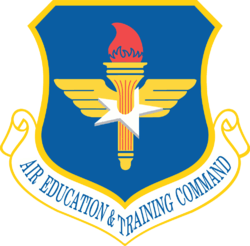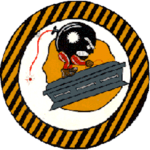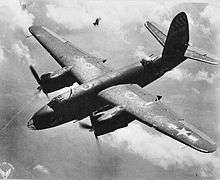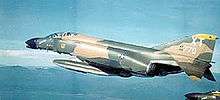558th Flying Training Squadron
558th Flying Training Squadron
 | |
|---|---|
 | |
| Active | 1942–1945; 1962–1970; 1992–1996; 2002–2006; 2010–present |
| Country |
|
| Branch |
|
| Role | Flying Training |
| Part of | Air Education and Training Command |
| Nickname(s) | Phantom Knights |
| Motto(s) | Semper Vigilamus Latin We are Always Vigilant |
| Engagements |
European Theater of Operations Vietnam War[1] |
| Decorations |
Distinguished Unit Citation Air Force Outstanding Unit Award with Combat "V" Device Air Force Outstanding Unit Award Republic of Vietnam Gallantry Cross with Palm[1] |
| Insignia | |
| 558th Flying Training Squadron emblem (approved 25 August 1995)[1] |
 |
| 558th Tactical Fighter Squadron emblem (approved 17 May 1965)[1] |
 |
| Unofficial 558th Bombardment Squadron emblem[2][3] |
 |
| World War II fuselage code[2] | KX |
The 558th Flying Training Squadron is a United States Air Force unit assigned to the 12th Flying Training Wing at Randolph Air Force Base, Texas. The squadron trains individuals on how to operate Remotely Piloted Aircraft.
The first predecessor of the squadron is the 558th Bombardment Squadron, a Martin B-26 Marauder unit that served in the European Theater of Operations, where it earned a Distinguished Unit Citation for action in combat.
The squadron's other predecessor is the 558th Tactical Fighter Squadron organized as part of the Air Force's first McDonnell F-4 Phantom II wing. The squadron served in combat in the Vietnam War until its inactivation in 1970. The two squadrons were consolidated in 1985 and activated as a flying training unit in 1992.
Overview
"In a response to the dangers of insurgent warfare, Randolph AFB has assigned a new squadron that will eventually train more than 500 airmen annually to fly and operate remotely piloted aircraft.
The May 20, 2010 reactivation of “The Phantom Knights” — Randolph's 558th Flying Training Squadron — will make Randolph officially the Air Force's only site to offer undergraduate, or beginning, training in remotely piloted aircraft. Training in a test program has been taking place for about 1½ years there.
It marks the base's commitment to providing “the most sought-after capability in theater,” Lt. Col. Bryan Runkle, who will assume command of the squadron, said in a release. “I'm honored to be part of the Air Force's first squadron dedicated to RPA training.”
Randolph officials are calling the move historic, since the squadron will train students on RPAs as their first aircraft and sensor operators entering their first career field. An RPA flight crew typically has one sensor operator responsible for controlling video, radar and weapons equipment.
The 12th Flying Training Wing, Randolph's host unit since 1972, conducts training for instructor pilots, combat systems officers and student fighter pilots. The 558th, with roots dating to 1942, was last activated to fly T-6As at Randolph in 2002, and then inactivated when another squadron took over that mission in 2006.
The new squadron will be the home of undergraduate training for the MQ-1 Predator, MQ-9 Reaper and RQ-4 Global Hawk. Randolph began an RPA fundamentals course in the fall 2008, and last year ran a “Beta test class” through an instrument qualification course on RPAs, base officials said. Last August, the base began a basic sensor operators' course.
While many still join the Air Force in hopes of flying manned bombers, fighters and tankers, many are going into operation of RPAs because it's a career growth area and is important in today's battlefield, Air Force officials said.
Residents of areas near the base won't see the aircraft flying, since most of the training at Randolph will be taught in classrooms or on simulators. Formal training on RPAs will occur at Creech AFB, Nev.; Holloman AFB, N.M.; Beale AFB, Calif.; and March AFB, Calif.
Simas said the Air Force prefers the acronym RPA to UAV — unmanned aerial vehicle."[4]
History
World War II

Activated as a Martin B-26 Marauder medium bombardment squadron in late 1942. Trained under Third Air Force and deployed to European Theater of Operations (ETO) in July 1943. Initially being stationed in England and assigned to IX Bomber Command,
Engaged in tactical bombardment of enemy targets in Occupied Europe initially from stations in England, then after D-Day, moved to Advanced Landing Grounds in France and Belgium; advancing eastward as Allied ground forces advanced. Supported Eighth Air Force strategic bombardment missions over Nazi Germany and Occupied Europe; striking enemy airfields to obtain maximum interference in Luftwaffe day interceptor attacks on heavy bomber formations returning to England. Also participated in Western Allied Invasion of Germany, March–April 1945, combat ending with German Capitation in May 1945.
Became part of the United States Air Forces in Europe while squadron demobilized personnel in 1945. Squadron reassigned to the United States as a paper unit, inactivated in November 1945.
Vietnam War

Activated in 1962 as one of the initial McDonnell F-4C Phantom II fighter squadrons when the aircraft was made operational by the Air Force. When activated, F-4Cs were not yet in production. In order to get the squadron operational, second-line Republic F-84F Thunderstreaks were transferred from the Air National Guard. Received Navy F4Hs (later F-4B) for training; receiving F-4Cs in January 1964. Deployed to South Vietnam during the Vietnam War and flew combat missions, primary over North Vietnam until Cam Ranh Air Base was closed in November 1970.
Flying training
Reactivated as a training squadron in 1992, it specialized in undergraduate navigator training from, 15 December 1992 – 1 October 1996 and 16 January 2002 – 28 September 2006.
Reactivated in 2010 for MQ-1 Predator operator flight training.
Lineage
- 558th Bombardment Squadron
- Constituted as the 558th Bombardment Squadron (Medium) on 25 November 1942
- Activated on 1 December 1942
- Redesignated 558th Bombardment Squadron, Medium on 9 October 1944
- Inactivated on 12 Nov 1945
- Consolidated with the 558th Tactical Fighter Squadron as the 558th Tactical Air Support Squadron on 19 September 1985[1]
- 558th Flying Training Squadron
- Constituted as the 558th Tactical Fighter Squadron and activated, on 17 April 1962 (not organized)
- Organized on 25 April 1962
- Inactivated on 31 March 1970
- Consolidated with the 558th Bombardment Squadron Squadron as the 558th Tactical Air Support Squadron on 19 September 1985 (remained inactive)
- Redesignated 558th Flying Training Squadron on 14 December 1992
- Activated on 15 December 1992
- Inactivated on 1 October 1996
- Activated on 16 January 2002
- Inactivated on 28 September 2006
- Activated on 20 May 2010[1]
Assignments
- 387th Bombardment Group, 1 December 1942 – 12 November 1945
- Tactical Air Command, 17 April 1962 (not organized)
- 12th Tactical Fighter Wing, 25 April 1962 – 31 March 1970 (attached to 51st Fighter-Interceptor Wing 9 March–9 June 1965, 18th Tactical Fighter Wing, 3 February–22 July 1968
- 12th Operations Group, 15 December 1992 – 1 October 1996
- 12th Operations Group, 16 January 2002 – 28 September 2006
- 12th Operations Group, 20 May 2010 – present[1]
Stations
|
|
Aircraft
- Martin B-26 Marauder (1942–1945)
- Republic F-84 Thunderstreak (1962–1963)
- McDonnell F-4 Phantom II (1963–1970)
- Boeing T-43 Bobcat (1992–1996, 2002–2006)[1]
References
- Notes
- ↑ Aircraft is Martin B-26C-15-MO Marauder serial 41-34968 "Lorelei" . This plane was shot down on 23 June 1944.
- Citations
- 1 2 3 4 5 6 7 8 9 Robertson, Patsy (June 30, 2010). "Factsheet 558 Flying Training Squadron (AETC)". Air Force Historical Research Agency. Retrieved June 28, 2017.
- 1 2 Watkins, pp. 106-107
- ↑ See Maurer, Combat Squadrons, p. 659 (no official emblem)
- ↑ Huddleston, Scott (May 18, 2010). "Randolph to launch training on drones". MySA. Retrieved June 28, 2017.
- 1 2 Station numbers in Anderson
- 1 2 3 4 5 Station numbers in Johnson
Bibliography
![]()
- Anderson, Capt. Barry (1985). Army Air Forces Stations: A Guide to the Stations Where U.S. Army Air Forces Personnel Served in the United Kingdom During World War II (PDF). Maxwell AFB, AL yes: Research Division, USAF Historical Research Center. Archived from the original (PDF) on January 23, 2016. Retrieved June 28, 2017.
- Johnson, 1st Lt. David C. (1988). U.S. Army Air Forces Continental Airfields (ETO) D-Day to V-E Day (PDF). Maxwell AFB, AL: Research Division, USAF Historical Research Center. Archived from the original (PDF) on September 29, 2015. Retrieved June 26, 2017.
- Maurer, Maurer, ed. (1983) [1961]. Air Force Combat Units of World War II (PDF) (reprint ed.). Washington, DC: Office of Air Force History. ISBN 0-912799-02-1. LCCN 61060979.
- Maurer, Maurer, ed. (1982) [1969]. Combat Squadrons of the Air Force, World War II (PDF) (reprint ed.). Washington, DC: Office of Air Force History. ISBN 0-405-12194-6. LCCN 70605402. OCLC 72556.
- Ravenstein, Charles A. (1984). Air Force Combat Wings, Lineage & Honors Histories 1947-1977 (PDF). Washington, DC: Office of Air Force History. ISBN 0-912799-12-9. Retrieved December 17, 2016.
- Watkins, Robert (2008). Battle Colors. Vol III Insignia and Markings of the Ninth Air Force In World War II. Atglen, PA: Shiffer Publishing Ltd. ISBN 978-0-7643-2938-8.
